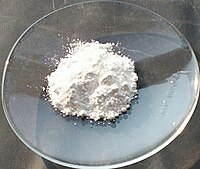
Photo from wikipedia
Abstract Mesoporous silica-graphite composite (SiO2/C-graphite) was synthesized by the sol-gel technique. The surface area (SBET = 98.93 m2/g), pore volume (0.30 cm3/g) and pore size (12.16 nm) were characterized by BET. The novelty of this… Click to show full abstract
Abstract Mesoporous silica-graphite composite (SiO2/C-graphite) was synthesized by the sol-gel technique. The surface area (SBET = 98.93 m2/g), pore volume (0.30 cm3/g) and pore size (12.16 nm) were characterized by BET. The novelty of this work lays in the fabrication of material in which ceramic material (SiO2/C-graphite) was decorated with copper oxide (CuO) nanostructure. SEM images revealed material compactness without phase segregation and EDX mapping showed a homogenous structure. Pressed disk electrode fabricated with SiO2/C/CuO nanocomposite material was evaluated as an amperometric non-enzymatic glucose sensor in 0.1 M NaOH solution. The linear response range, sensitivity, detection limit, and quantification limit were 0.02–20.0 mmol L− 1, 0.06 μmol L− 1, 472 μA mmol− 1 L− 1 cm− 2, and 0.76 mmol L− 1, respectively. The electrode response time is
Journal Title: Journal of Molecular Liquids
Year Published: 2017
Link to full text (if available)
Share on Social Media: Sign Up to like & get
recommendations!